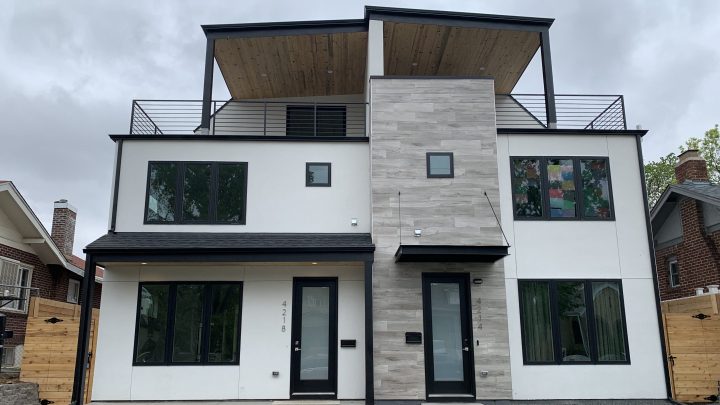
Invasion of the luxury duplexes in Denver

Walk around parts of Denver’s Berkeley neighborhood, and you’ll see a strange mix of century-old bungalows with big yards and front porches, and modern duplexes with balconies and roof decks. From the looks of it, the duplexes are winning.
“Here’s another single-story that’s going to be demolished,” said Bill Killam, walking past a small white house with an overgrown yard and temporary chain-link fence. “And another new one right next door.”

Killam has lived here for 30 years and volunteers with Historic Berkeley Regis, a neighborhood preservation group. He said the duplexes started popping up about 10 years ago as the country was coming out of the recession.
“There was a lot of money floating around, and a lot of these houses were able to be bought up fairly inexpensively because it was at the bottom of the market,” he said.
Developers saw they could make a lot of money tearing down one little house and replacing it with two big ones under one roof. And as Denver became a magnet for young professionals, there was plenty of demand for these spacious, modern homes — but also plenty of resistance from longtime residents, who felt these giant boxes were destroying the character of their neighborhoods. And in 2010, when the city went through a big rezoning process, officials put on the brakes.
The 2010 zoning code “actually down-zoned about 75% of Denver to single-family as a result of that pushback on density and duplexes,” said architect Gosia Kung. So much of the city was suddenly off limits for this kind of building, there was a frenzy to grab what was left. “There are these few pockets,” she said. “Those are the ones that are targeted by developers.”
Developers like Jay Feaster.
“I don’t have horns, even though some folks would say that I probably do,” he said. One of his new projects is in a neighborhood called Sunnyside. Each side of the duplex has three bedrooms and four bathrooms, huge windows, gleaming white cabinets and hardwood floors. “My wife refers to the kitchen island as the aircraft carrier, because it’s 13 feet long,” he said.

In theory, two connected homes where there used to be one is what a growing city like Denver needs. Duplexes are part of what’s called the “missing middle” between apartment buildings and detached single-family homes. Minneapolis recently banned exclusive single-family zoning in most of that city to promote more density, and Oregon just adopted a similar measure for much of the state. But as Denver has boomed and land has grown more expensive, so have the houses. Each half of Feaster’s duplex sold for more than $800,000.
He thinks the city’s attempts to restrict density backfired and pushed up prices.
“I feel like if they didn’t concentrate the zoning, No. 1, it would have helped prices stay a lot more attainable,” he said. “But simultaneously you wouldn’t have all these three-story units, because people would try to be blending into the neighborhood more.”
Feaster said he’s been building more two-story duplexes with traditional features, like pitched roofs and big front porches. “We’re hoping that those maybe are a little bit more warmly received,” he said.
But it’s not just the architecture that bugs people. As we talked on the roof deck, there was a TV crew down below interviewing the next-door neighbor on the front stoop of his bungalow. His name is Bobby LeFebre, and he’d written a play about what’s happening to his part of the city.
“Northside” is about a young Chicano couple, Teo and Luna, trying to buy a house in their working-class neighborhood as it gentrifies. They end up in a bidding war with a white couple from the suburbs, who embody the changing demographics. Gone are the bilingual bookstores and old Chevy Impalas, LeFebre writes, replaced by boutiques and Mercedes.
“If we don’t get into something here soon, I don’t know if we’ll be able to afford it later,” Teo says. “Sometimes I look at what it’s become, and I wonder if it’s even worth sticking around for,” Luna replies.

LeFebre didn’t want to be interviewed for this story. One of the actors, Angel Mendez-Soto, has lived in Sunnyside for more than 40 years. He said all the development in his neighborhood has pushed up the value of his house to more than 10 times what he paid for it in the 1980s. But the bungalow that used to be next door has been replaced — by a giant duplex with a roof deck.
“Before, you’d sit on the porch and there’d be a neighbor sitting on the porch across, and there might be a cross conversation,” Mendez-Soto said. “How do you talk to somebody who’s looking down on you? It’s a very weird situation.”
It’s a situation city officials say they plan to address with zoning changes that promote what’s been called “gentle density,” adding much-needed housing without destroying the character of the existing neighborhood.
There’s a lot happening in the world. Through it all, Marketplace is here for you.
You rely on Marketplace to break down the world’s events and tell you how it affects you in a fact-based, approachable way. We rely on your financial support to keep making that possible.
Your donation today powers the independent journalism that you rely on. For just $5/month, you can help sustain Marketplace so we can keep reporting on the things that matter to you.


















